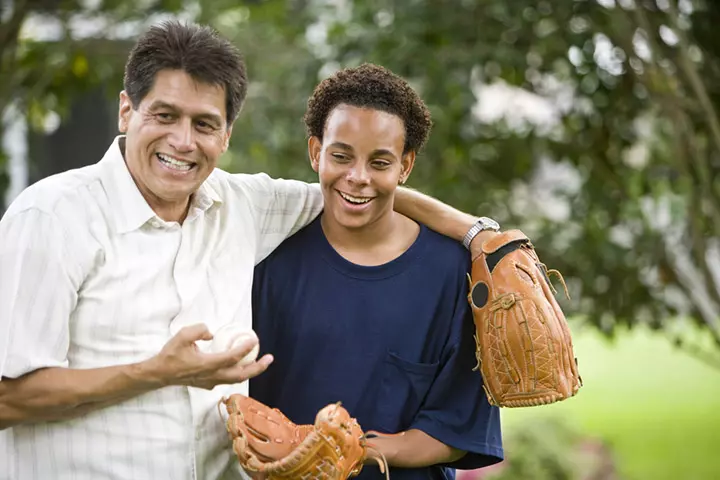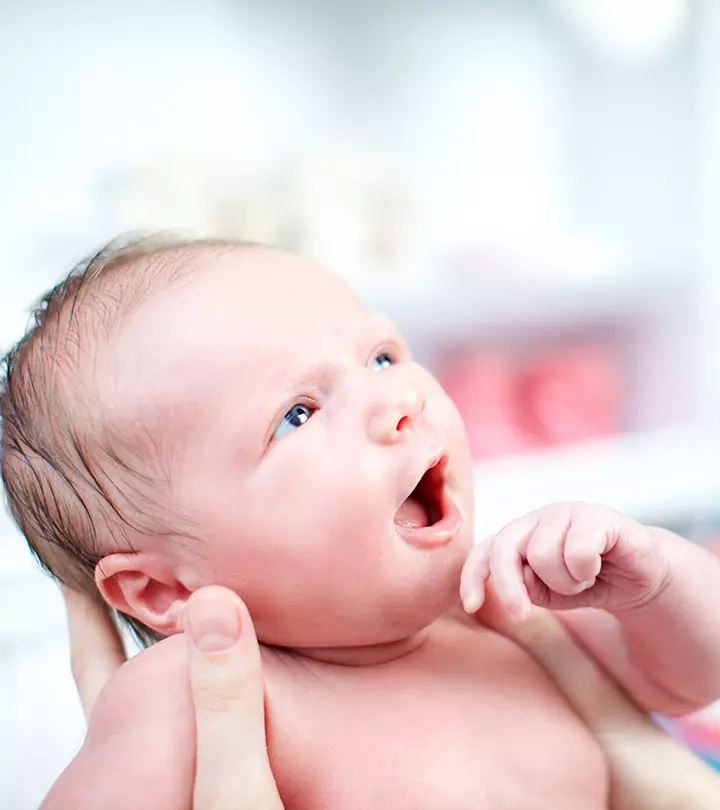
Image: ShutterStock

Puberty is when a child transitions to adulthood physically, mentally, and emotionally. Though both males and females undergo several changes, physical changes during puberty differ in boys and girls.
Several secondary sexual characteristics begin to develop in puberty. For example, girls may begin to menstruate, while boys develop mustaches and beards, and their voices deepen. These changes may begin at different times in each child. Some may have early puberty, while in others, there is a delay. Understanding the significance of physical and emotional changes during puberty is crucial for both children and parents. Open communication is vital in helping adolescents navigate this transformative period, allowing them to express concerns and ask questions. Read on to know more about physical changes in puberty for boys and girls and seek medical care if puberty is delayed.
Key Pointers
- Boys and girls experience different physical changes during puberty.
- Girls typically experience their growth spurt around age 11, while boys start at age 13.
- Puberty brings about secondary sexual traits such as menstrual cycles for girls and deeper voices for boys.
- Boys’ hair growth pattern may resemble that of adults, while girls may develop breasts and wider hips.
- Teenagers may feel overwhelmed by the changes during puberty, so parents should be supportive and understanding.
12 Physical Changes During Puberty
Puberty typically begins between ages 9 and 13 years for boys and girls. Some children may experience the onset of puberty earlier or later than average, which is still considered normal. A combination of genetic, environmental, and health factors influences these changes. Some major changes occur in adolescent boys and girls during this period as the body starts to develop and attain physical maturity. This is the time when your child’s body will start developing all the secondary sexual characteristics. Many teens and families are hesitant or feel awkward to discuss body changes. It is important to speak to your child before these changes begin to appear so they know what to expect. You may reach out to your pediatrician if you have any concerns.
Physical Changes In Girls During Puberty
The physical changes for females during puberty experience are marked by the following features of growth (1):
- Puberty in girls is marked by the start of the menstruation cycle, commonly referred to as periods.
 Point to consider
Point to consider
Image: Shutterstock
- During adolescence, significant physical changes occur, including breast development, which typically reaches full growth by the age of 17. However, some girls might take a little longer as the breast development rate is different for everyone (2). The earliest sign of puberty is the development of breast buds.
- Hair growth in the pubic area and the armpits are also observed. The growth of pubic hair may be the first sign of puberty in about 15% of all pubertal girls.
- The adolescent years are also marked by a rapid growth spurt. In girls this growth spurt starts at the age of 11 or usually around the time she reaches menarche and slows down by the age of 16 (3).
- As girls go through puberty, they will notice changes in their body shape. The hips may also widen, resulting in a curvier body shape. It is common for fat to accumulate in areas like the buttocks, stomach, and legs during this time (4) (5).
 Health fact
Health factPhysical Changes In Boys During Puberty
The physical changes during puberty for males are different from females in a number of ways. The developments that a boy undergoes during adolescence are (6):
- In boys, the scrotum and the testicles start to grow when they reach puberty.
- The penis also increases in length and reaches the proper adult size and shape by the age of 17 or 18 (7).
They also begin to experience erections due to hormonal changes.
- Facial hair, as well as hair growth in the pubis area, armpits, and chest, have been observed. This usually starts around the age of 12; by the time the boy reaches 18 years, the pattern of body hair growth resembles those of adults.
- The teenage growth spurt starts at about 13 years and continues on to about 18 years of age in boys. After that, the growth slows down (3).

Image: Shutterstock
- Adolescent boys commonly experience voice changes as a part of their physical transformation. Their vocal cords grow and as a result, the voice pitch changes into a heavier tone.
- When boys go through puberty, their bodies start producing sperm. Sometimes, during an erection, a mix of sperm and other fluids called semen is released from the body. This is known as ejaculation. Occasionally, this can happen while the boy is asleep, which is called a wet dream or nocturnal emission. It is all a normal part of growing up (6).
- Boys gain muscle mass as they go through puberty. Their body shape starts to change with broader shoulders, weight gain, and muscle growth. By around age 16, most boys have finished growing taller, but their muscles keep getting stronger and developing (8) (9).
 Did you know?
Did you know?How To Help An Adolescent Cope With The Changes?
Here are some points to keep in mind as your adolescent goes through these changes (6) (7):
- It is important to remember that though the physical development in adolescence is rapid, the mental faculties are still in the developmental stage.
- With adolescence comes a whole new range of emotions, a new found sense of responsibility and freedom, and a lot of physical changes. Children are sometimes unable to keep pace with all the changes occurring in their bodies.
- Most times, adolescents distance themselves from their parents and tend to resort to their peer group for answers. It is at this point that you as the parent need to step forward and be a friend and guide to your child.

Image: Shutterstock
- Make sure that your child is well-informed about all the physical changes they would be experiencing during adolescence.
Lucinda, a mother, shares her own experience with puberty and how she supports her young daughter going through the same. She says, “I went through puberty being bad tempered, obstinate and misunderstood… But now I see my daughter of 13 having mood swings and I want to know more of that. I want to be there for her notwithstanding my limitations and own life challenges.
“We talk more about her life and day to day experiences. Thank God she (her daughter) likes the attention. So my asking her a lot of questions is not ‘awkward.’ She also shares her experiences with her older sisters, sometime they appear to be a better counselors just because they are more aware of the ‘signs of the time.’ One thing I know for sure is that my daughter of 13 can count on 3 people being actively involved with her puberty (i)!”
How To Discuss These Changes With An Adolescent
Having open and relaxed conversations before the pubertal changes commence can help your child feel comfortable with the changes in their body. Here are some tips on how to discuss these changes (10) (11).
- Provide clear and factual explanations of physical changes. For example, “Breasts start to develop as a normal part of puberty.”
- Use the right terms for body parts so your child learns the correct words and feels comfortable discussing their body.
- Highlight the fact that physical changes occur at different times for everyone. For instance, “While some children might experience a growth spurt in their early teens, others may go through it a bit later or earlier.”
- Choose a moment to talk when there are no distractions. Don’t be concerned if your child isn’t ready to share with you. They might feel more comfortable speaking with a counselor or your family doctor.
Frequently Asked Questions
1. How does the onset of puberty differ among girls of different ethnicities?
Girls of different ethnicities may experience differences in the onset of puberty. Studies indicate that African American girls tend to enter puberty earlier and have their first menstrual period earlier than Caucasian and Hispanic girls. It has also been observed that the trend toward earlier puberty timing has been happening faster in African American girls. The exact causes of these racial disparities in pubertal development are not fully understood. Therefore, further research is needed to explore potential genetic and environmental factors (12).
2. What are some common concerns or questions that girls have during puberty?
During puberty, girls experience significant physical and emotional changes, which can raise concerns and questions about different things. Some of them are what to expect from the first period and how to manage menstruation. They can also have queries about breast development and body changes, such as acne and secondary hair growth in the underarm and pubic area. Strategies to navigate social and emotional issues and exploring sexuality are some other domains that girls may seek guidance for.
3. How do hormonal changes during puberty affect girls’ moods and behavior?
The emotional changes during puberty experienced by girls are largely driven by hormonal fluctuations. This shift can lead to heightened emotional sensitivity and variability, which may cause girls to experience mood swings. They may also become more reactive to stress, making them more susceptible to experiencing anxiety or irritability. Hormone-induced physical changes during puberty may make girls more aware of their bodies and influence behaviors related to body images, such as an increased focus on appearance, comparisons with others, and increased sensitivity to criticism (13).
4. Can intense physical activity during puberty delay the onset of menstruation?
Intense physical activity during puberty may delay the onset of menstruation in some girls. The combination of high levels of physical activity, low body fat percentage, and energy imbalance may disrupt hormonal patterns and suppress the reproductive system. However, it’s important to note that individual factors, genetic predisposition, and overall health also affect the timing of menstruation onset. Consulting a healthcare professional can provide a more accurate assessment of an individual’s specific circumstances.
5. How does testosterone affect not only physical changes but also mental and emotional changes in boys?
Puberty causes a surge in testosterone production. Increased testosterone levels with other physical changes and social pressure may cause emotional outbursts and moody behavior in boys. Research shows that increased testosterone production can also influence brain development, affecting mood, behavior, and cognitive functions. It can increase aggression and risk-taking behavior and influence self-confidence, motivation, and sexual drive (14) (15) .
The physical changes during puberty in males and females can be overwhelming at times. Significant developments, such as hair growth in private areas, deepening voice in males, menstruation in females, may be confusing and quite a lot to take in. Therefore, this phase is when they need your utmost attention as their parents. Talk them through this phase, or better yet, it may be more beneficial to educate them beforehand and prepare them for changes they may experience as they proceed towards adulthood.
Infographic: Common Physical Changes In Boys And Girls During Puberty
Both boys and girls experience physical changes during puberty other than developing secondary sexual characteristics. Check out the below infographic to know the common physical changes during teenage years to know if there is a delay. Illustration: Momjunction Design Team
Illustration: Physical Changes That Occur During Puberty In Boys & Girls

Image: Stable Diffusion/MomJunction Design Team
Explore puberty-induced physical and emotional changes in this video that focuses on hormones and their effects on our bodies during this transformative phase.
Personal Experience: Source
MomJunction articles include first-hand experiences to provide you with better insights through real-life narratives. Here are the sources of personal accounts referenced in this article.
i. Puberty, life and other challenges;https://lucinda408.wordpress.com/2014/09/30/puberty-life-and-other-challenges/
References
- Physical development in girls: what to expect during puberty.
https://www.healthychildren.org/English/ages-stages/gradeschool/puberty/Pages/Physical-Development-Girls-What-to-Expect.aspx - How breasts develop during puberty.
https://breastcancernow.org/about-breast-cancer/awareness/signs-and-symptoms-of-breast-cancer/ - Physical development ages 11 to 14 years.
https://www.mottchildren.org/health-library/te7260 - Puberty: Teen Girl.
https://www.urmc.rochester.edu/encyclopedia/content.aspx?contenttypeid=90&contentid=P01635#:~:text=The%20girl%27s%20body%20shape%20will,that%20may%20happen%20during%20puberty. - Puberty
https://www.betterhealth.vic.gov.au/health/healthyliving/puberty - Puberty: Adolescent male.
https://www.hopkinsmedicine.org/health/wellness-and-prevention/puberty-adolescent-male - Is my body normal? (Boys).
https://www.betterhealth.vic.gov.au/health/healthyliving/Is-my-body-normal-Boys - Puberty
https://www.utmb.edu/pedi_ed/CoreV2/Adolescent/Adolescent4.html#:~:text=Both%20males%20and%20females%20start,females%20gain%20more%20adipose%20tissue. - Understanding Puberty
https://kidshealth.org/en/parents/understanding-puberty.html#:~:text=For%20a%20male%2C%20the%20physical,and%20erections%20happen%20more%20often. - Puberty: helping pre-teens and teenagers handle the changes
https://raisingchildren.net.au/pre-teens/development/puberty-sexual-development/puberty-helping-your-child - Parenting children through puberty and adolescence
https://www.betterhealth.vic.gov.au/health/healthyliving/Parenting-children-through-puberty#how-to-talk-about-puberty-and-body-image - Mary Scott Ramnitz and Maya B Lodish; (2013); Racial disparities in pubertal development.
https://pubmed.ncbi.nlm.nih.gov/23934693/ - Social and emotional changes in pre-teens and teenagers.
https://raisingchildren.net.au/pre-teens/development/social-emotional-development/social-emotional-changes-9-15-years - Puberty.
https://my.clevelandclinic.org/health/body/puberty - Corinna Laube et al.; (2025); Pubertal testosterone correlates with adolescent impatience and dorsal striatal activity.
https://www.ncbi.nlm.nih.gov/pmc/articles/PMC7242510/ - Physical Development in Boys: What to Expect.
https://www.healthychildren.org/English/ages-stages/gradeschool/puberty/Pages/Physical-Development-Boys-What-to-Expect.aspx
Community Experiences
Join the conversation and become a part of our nurturing community! Share your stories, experiences, and insights to connect with fellow parents.
Read full bio of Dr. Joel Warsh
Read full bio of Sakshi Mishra
Read full bio of Harshita Makvana
Read full bio of Shinta Liz Sunny

















